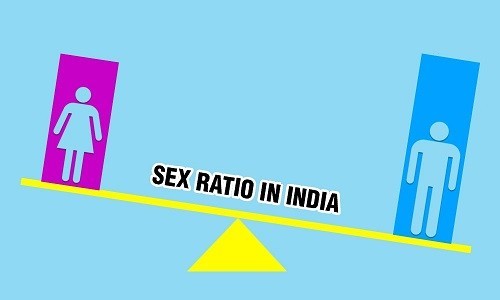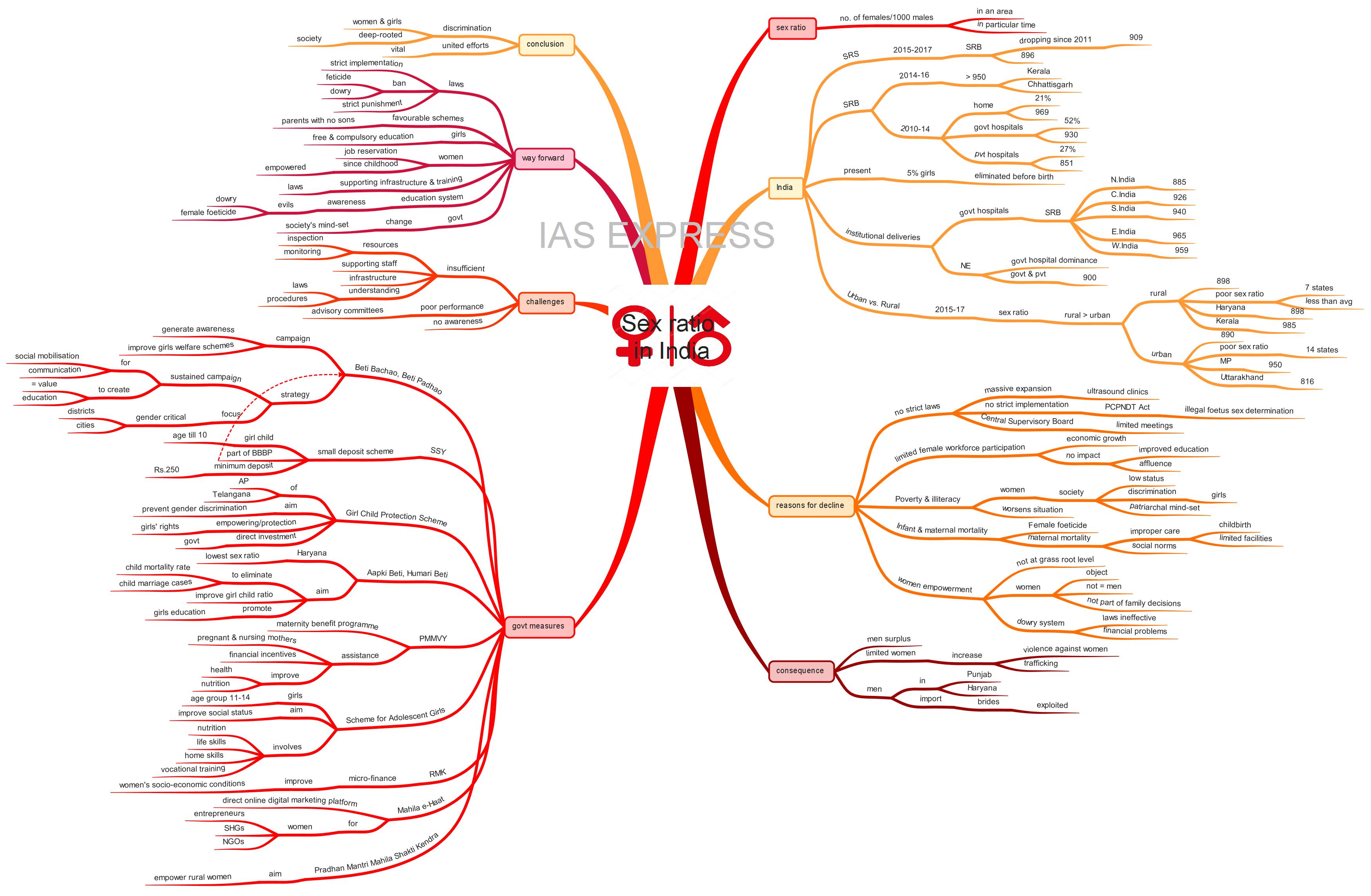Sex Ratio in India – Why is there a Decline?

Many efforts taken by the Indian government and various other organisations in recent years are not addressing the problem of the startling decline in India’s sex ratio since 2011. Many are alarmed that it would be reflected in India’s child sex ratio in the 2021 Census report.
What is the sex ratio?
- The sex ratio is the number of females per 1000 males in a particular area at a given time.
What is the sex ratio in India?
- As per the Sample Registration System (SRS) data released in July 2019 for the period of 2015-2017, the Sex Ratio at Birth (SRB) has been dropping continuously since Census 2011.
- The SRB has declined from 909 girls per 1000 boys in 2011-13 to 896 girls in 2015-17.
- In the 2014-16 period, of the 21 large states, only Kerala and Chhattisgarh had an SRB of above 950 girls per 1000 boys.
- Thus, presently, about 5% of girls are “eliminated” before they are born, despite the promises of the Beti Bachao Beti Padhao scheme.
- The SRB is different among the three points of delivery i.e., home, government hospitals and private hospitals when calculated using the data from National Family Health Survey-4 (NFHS-4).
- In the 2010-14 period, the distribution of births at home, government hospitals and private hospitals was 21%, 52% and 27% respectively and corresponding SRB figures were 969, 930 and 851.
- Further, when considering institutional deliveries in government hospitals, the SRB is falling.
- The worst regional SRB for the government sector was in Northern India (885 girls per 100 boys).
- It is somewhat better for Central India (926) and Southern India (940) while the performance of Eastern India (965) and Western India (959) was even better.
- In the Northeast, where there is the dominance of government hospitals, the government sector SRB rivalled that of the private sector (both are 900).
Urban vs. Rural:
- Even though the sex ratio in rural India has come down from 902 in 2014-16 to 898 in 2015-17, it is still higher than that of Urban India’s 890.
- 7 states had poor rural sex ratio than rural India’s average, while 14 states had a lower urban sex ratio than the average for urban India.
- The sex ratio at birth in urban areas ranges from 950 (Madhya Pradesh) to 816 (Uttarakhand).
- The sex ratio at birth in rural areas ranges from 898 (Haryana) to 985 (Kerala) respectively.
Why is there a decline in the sex ratio in India?
Absence of stringent implementation of laws:
- Through field surveys, it is found that there is a massive expansion of ultrasound clinics even in remote corners.
- Due to the absence of strict implementation of the Pre-Conception and Pre-Natal Diagnostic Techniques (Prohibition of Sex Selection) Act (PCPNDT Act), anyone who wants to determine the sex of the foetus can get it done illegally.
- The Central Supervisory Board established under the PCPNDT Act has not met for more than a year.
Limited female workforce participation:
- India has adopted an economic growth path where female workforce participation is low and the women cannot find viable employment.
- The trend where the families with girls keep having children until they have a male child still exists.
- Improving education levels and affluence alone has had no impact.
- In fact, due to the gender-excluded nature of India’s growth, the situation in urban India is far worse than rural India when it comes to poor sex ratio.
Poverty and illiteracy:
- The low status of women within society leads to the discrimination of the girl child.
- Society’s patriarchal mind-set, poverty and illiteracy among women contribute to the declining sex ratio in India.
Infant and maternal mortality:
- The infant mortality rate is the number of deaths of babies before the age of one. Female foeticide significantly contributes to the current trend.
- Maternal mortality also contributes to this situation. This is due to improper care during childbirth and limited facilities.
- The social norms in India make it difficult for women to get the necessary care before and during childbirth.
Women empowerment – not at the grass-root level:
- In most parts of India, women are merely considered as an object and not on par with men.
- Women are mostly not part of the family decisions and they are forced to abide by unfair norms.
- The dowry system, despite being made illegal, still exists within the Indian society and the government’s measures have proven to be ineffective due to the social norms and traditions.
- Due to the financial problems that arise because of the dowry practises, many families in rural India prefer a male child to a female.
What are the consequences of the low sex ratio?
- Low sex ratio at birth has led to an increase in “surplus men” in countries like India and China.
- Due to limited women within society, there is an increase in the cases of violence against them.
- There are even cases of an increase in human trafficking.
- In India, some villages in Haryana and Punjab, because of the poor sex ratio, men “import” brides from other states. This is often accompanied by the exploitation of these brides.
What are the measures taken by the government to deal with the declining sex ratio?
The government introduced several schemes to deal with the poor sex ratio. Some of them are as follows:
Beti Bachao, Beti Padhao:
- It is a government campaign that aims to generate awareness and improve welfare services intended for girls.
- The strategies used include:
- Implementation of sustained social mobilisation and communication campaign to create equal value for the girl child and promote her education.
- Place the issue of decline in child sex ratio/sex ratio at birth in public discourse, improvement of which would be an indicator for good governance.
- Focus on gender critical districts and cities.
Sukanya Samriddhi Yojana (SSY):
- SSY is a small deposit scheme for the girl child launched as a part of the ‘Beti Bachao, Beti Padhao’ campaign.
- The account can be opened at any time after the birth of the girl until she turns ten, with a minimum deposit of Rs.250.
Balika Samriddhi Yojana:
- Balika Samriddhi Yojana is another central government scheme to assist girls in financially vulnerable sections of society.
- This scheme assures the enrolment and retention of girl children in primary and secondary schools.
- It aims at ensuring the prosperity of a girl child and provides them with a better quality education.
- To get the benefits of Balika Samriddhi Yojana, the girl child should belong to a family below the poverty line (BPL).
Ladli Scheme:
- This scheme was launched by the Haryana government under the state’s Ministry of Child and Women’s Development.
- Haryana is mainly a male-dominated state and the birth of a girl is interpreted as a bad omen in several areas.
- Therefore, this scheme was launched to eradicate the stigma associated with the birth of a girl.
- This scheme aims at spreading awareness regarding the protection of girls for improving the sex ratio of the state and better education facilities for females across the state.
Girl Child Protection Scheme:
- Girl Child Protection Scheme of the governments of Andhra Pradesh and Telangana aims to prevent gender discrimination by empowering and protecting the rights of the girl children through direct investment from the government.
Aapki Beti, Humari Beti:
- Haryana has the lowest sex ratio in India.
- In order to deal with this issue, the Haryana government had launched this scheme with an aim to eliminate child mortality rate and child marriage cases in society.
- This scheme also aims to improve the girl child ratio.
- It promotes girls education within the state.
Pradhan Mantri Matru Vandhana Yojana (PMMVY):
- It is a maternity benefit programme that assists pregnant and nursing mothers by providing them with financial incentives so that they have improved health and nutrition.
Scheme for Adolescent Girls:
- The scheme focuses on girls in the age group 11-14.
- It aims to empower and improve their social status through nutrition, life skills, home skills and vocational training.
National Nutrition Mission (NNM):
- It aims to improve the nutritional status of pregnant women and lactating mothers and reducing anaemia among women along with children.
Rashtriya Mahila Kosh (RMK)
- It provides micro-finance to improve social and economic conditions of women
Mahila e-Haat:
- It is a unique direct online digital marketing platform for women entrepreneurs/SHGs/NGOs.
Pradhan Mantri Mahila Shakti Kendra:
- It aims to empower rural women through community participation to create an environment where they can realise their full potential.
What are the challenges while implementing the schemes and laws for women empowerment?
- There are no sufficient resources to undertake inspection and monitoring.
- Insufficient qualified staff
- The poor performance of advisory committees at various levels
- Insufficient understanding of laws and procedures.
- Lack of awareness
- Limited infrastructure to support the implementation of these schemes
What can be the way forward?
- Stringent implementation of the laws that ban foeticide and dowry by the government and severe punishment for those who do not comply;
- Providing favourable schemes for those parents who have no sons;
- Free and compulsory education for girls;
- Women should be provided with job reservations;
- Supporting infrastructure and training should be ensured for the implementation of the related laws;
- The education system must focus on providing awareness about the women empowerment and the evils of dowry and female foeticide
- Women, from early childhood, must be empowered and socialised so that they consider themselves to be on par with men.
- The government should focus on changing society’s mindset to address this issue.
Conclusion
The issue of discrimination of women and girls is deep-rooted within Indian society and cannot be addressed in isolation. United efforts of people from all walks of life are vital to deal with this issue.
Test yourself
What is the sex ratio? Why are the government’s measures failing to address the current decline in the sex ratio of India? (250 Words)
If you like this post, please share your feedback in the comments section below so that we will upload more posts like this.



very nicely covered
references may be added in the end further reading and value addition